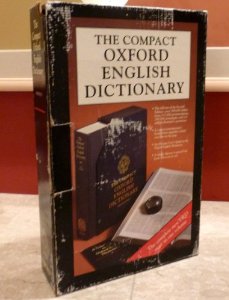
What: Any book of words that tells you what’s built into them, whether it’s a dictionary of hobby-related vocabularies or a more complete overview. I’ve got a shelf’s worth of them, including a number of foreign language dictionaries and the beloved Compact edition of the OED my brother gave me one year.
Who: If you are someone who uses words, and want to make sure you are using them correctly, use a dictionary. A while back while I was teaching at Hopkins, a student handed in a piece that was unsettling in a way I’d never encountered before, consistently misusing words. When we talked about it, she revealed she’d written the piece and then used a thesaurus “to make the words fancier.”
Why: If you are going to write, you must know how to use words. They are the basic building block of the trade. Read the dictionary in order to use them with rigorous precision, an appreciation for their history, and an understanding of their grammatical use.
When: All the time. On your phone. While waiting for your bus. When you want to refill your tank of words.
Where and how: The deeper the dictionary, the more interest it holds for me. I like specialized dictionaries that list fashion terms or kinds of birds or words taken from other languages.
#sfwapro




